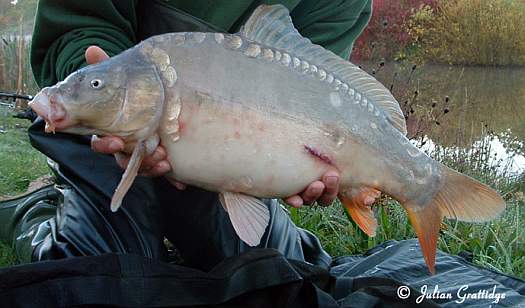All (true) carp anglers realise the importance of looking after fish, and ensure they always have unhooking mats, slings and suchlike to care for their quarry on the bank. However, as with most things, going the extra mile can make a massive difference.
It’s quite often the case that when a fish is on the bank, you might spot an injury the fish has sustained in its day to day life, or a lifted scale or heavy hookhold. Many anglers will simply place the fish back in the water thinking that Mother Nature will take care of anything that needs fixing and think nothing more of it.
If it’s a really healthy water where the fish are not placed under any undue pressure or stress, where they receive a good amount of food full of the nutrition and vitamins needed to sustain healthy body and tissue repair, and where the water is clear of excess parasites and suchlike, then yes, they should be able to look after themselves. However, if an extra minute’s treatment on the bank meant that it was all taken care of for them, then surely that would be a good thing? Not to mention the fact that many waters are far from the ideal mentioned!
I’ve always been a big believer in treating fish on the bank; I’ve just never liked the idea of returning a fish with an obvious wound to fend for itself. If we can spend thousands of pounds on tackle, all designed to catch them, then surely we can spend a tenner on a bottle of antibacterial treatment to help treat any wounds they may have once we’ve caught them?
Fish are just like us and will pick up all kinds of knocks and injuries; some more serious than others. Many, they’ll be able to shrug off themselves, but some, if left without treatment, could easily lead to further complications to the point where, if left untreated, the fish could easily be lost.
Therefore, I’ve always treated hookholds, and anything else that looks in the slightest bit suspect, to help ensure the fish always has the best chance possible of seeing off any infections or injuries picked up. I fully understand some people may be suspect of whether such treatments actually do any good, and some even say you would be better doing nothing, but my personal experience, both as a seasoned angler and a fishery manager, is that preventative treatment is always beneficial.
I’ve seen it on many occasions where a carp has been returned without any treatment, and next time on the bank, be it a short or long time after, the injury is still there – sometimes diminishing, sometimes worse, but more often than not, signs are still visible. By comparison, on waters where the anglers all treat the fish they catch, the fish seem to heal much, much quicker, and in many cases, the next time on the bank there is no visible sign that a sore or cut was ever there. A good example is the fish pictured. This was a young Priory stocked to one of my waters. It went in mint, but the first time it came to the bank it had picked up quite a nasty cut which at its deepest point was a good 8mm deep.

Scar before treatment…

Scar now gone!
We cleaned and treated the cut with an antifungal and antibacterial cleanser before putting it back. It’s properly sticky stuff designed to stay on even after the fish is back in the water, helping to heal the injury and keep it free from infection. Although a poor image, the next time it came out, as you can see, there is no trace that the injury was ever there at all – there was not even a scar! Happily, it’s been much the same case with other fish on my syndicate lake treated in the same way. To be honest, I actually make it a rule of membership that all members carry some sort of wound treatment in their tackle, and I’m surprised more waters don’t do the same.
Quality specimen fish don’t come cheap, and it’s down to those running the waters to ensure those fishing them do their bit to make sure their stock lives happy and healthy to a ripe old age.
There are plenty of types available;
The Korda Fishcare Kit contains a full on medi-pac for carp with different treatments for mouth and body, retailing at around £14.99. CLICK HERE for details.
Nash Tackle does a similar Medi Carp Kit with a single treatment formula, cleansing buds, towel and carry pouch for around £11.99. CLICK HERE for details.
TF Gear have recently launched Carp Aid, which retails at around £7.99. I haven’t seen this, but it may be worth a look. CLICK HERE for details.
Kryston also do a few different wound treatments, a quick search for ‘Klin-ik’ on eBay will bring them all up. You can buy them on their own or as part of a set with prices starting at around £6.30. CLICK HERE for details.
Personally, I use Tamodine veterinary wound cleanser. It was recommended to me by a fish farmer many years ago and I’ve been using it ever since. It stays on the fish for ages – many a time I’ve spotted a fish with deep orange blobs on that I’ve caught and treated weeks before! Also, as it’s not a fishing brand, it’s much cheaper – I usually buy 100ml bottles for around £9.00 off eBay, so you get pretty much twice as much for your money. CLICK HERE for more details.
To be honest, I don’t really recommend one over another – it’s using one at all that matters!
If we want the young carp of today to be the specimens of tomorrow, then we all need to play our part and look after them as best we can on the bank.
Julian Grattidge
March 2013









